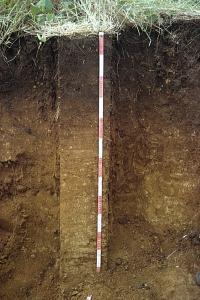Reference soil Nicaragua 08: Andosol
Andosols occur throughout the world where volcanic activity is common, especially in the circum-Pacific region and along the mid-Atlantic Ridge.
Characteristics
Soils with a vitric or andic horizon (slightly to moderately weathered horizons in pyroclastic deposits dominated by short-range-order minerals, notably allophane and imogolite) starting within 25 cm from the soil surface. In addition, they may have a histic, fulvic, melanic, mollic, umbric, ochric, duric, or cambic horizon. Other diagnostic horizons (unless buried deeper than 50 cm by volcanic deposits) are absent.
Reference soil NI008: Andosols
Deep, well drained, (dark) reddish brown clay to silty clay soil developed from alluvium, derived from consolidated pyroclastic materials. The soil contains few pyroclastic fragments, is friable, strongly to moderately structured, moderately to slowly permeable and moderately porous. This well developed soil shows differentiation in color and texture (illuvial Bt horizon). The profile forms part of the NIC05 to NIC09 toposequence. NIC08 ("red soils") and NIC09 ("black soils") are both found at short distances in an irregular pattern, in consequence of differences in drainage conditions (well c.q. imperfectly drained).
